- News
- Reviews
- Bikes
- Accessories
- Accessories - misc
- Computer mounts
- Bags
- Bar ends
- Bike bags & cases
- Bottle cages
- Bottles
- Cameras
- Car racks
- Child seats
- Computers
- Glasses
- GPS units
- Helmets
- Lights - front
- Lights - rear
- Lights - sets
- Locks
- Mirrors
- Mudguards
- Racks
- Pumps & CO2 inflators
- Puncture kits
- Reflectives
- Smart watches
- Stands and racks
- Trailers
- Clothing
- Components
- Bar tape & grips
- Bottom brackets
- Brake & gear cables
- Brake & STI levers
- Brake pads & spares
- Brakes
- Cassettes & freewheels
- Chains
- Chainsets & chainrings
- Derailleurs - front
- Derailleurs - rear
- Forks
- Gear levers & shifters
- Groupsets
- Handlebars & extensions
- Headsets
- Hubs
- Inner tubes
- Pedals
- Quick releases & skewers
- Saddles
- Seatposts
- Stems
- Wheels
- Tyres
- Health, fitness and nutrition
- Tools and workshop
- Miscellaneous
- Buyers Guides
- Features
- Forum
- Recommends
- Podcast
review
£3,700.00
VERDICT:
Radical looks but the Strada is a fast, comfortable and exciting aero race bike that works brilliantly
Weight:
7,700g
Contact:
At road.cc every product is thoroughly tested for as long as it takes to get a proper insight into how well it works. Our reviewers are experienced cyclists that we trust to be objective. While we strive to ensure that opinions expressed are backed up by facts, reviews are by their nature an informed opinion, not a definitive verdict. We don't intentionally try to break anything (except locks) but we do try to look for weak points in any design. The overall score is not just an average of the other scores: it reflects both a product's function and value – with value determined by how a product compares with items of similar spec, quality, and price.
What the road.cc scores meanGood scores are more common than bad, because fortunately good products are more common than bad.
- Exceptional
- Excellent
- Very Good
- Good
- Quite good
- Average
- Not so good
- Poor
- Bad
- Appalling
Review first published 22nd November 2017
The new 3T Strada has blown me away. It's a truly stunning bike with breathtaking speed, impressive smoothness and fine handling balance. If this is the future, as some people have speculated, I'm sold. Take my money 3T.
- Pros: Fast, comfortable, wide gear range, disc brakes, aggressive position
- Cons: Gaps between certain gears with this particular build, very pricey
As for the issues about clearance and gearing – the two key talking points since the bike launched – well, they simply fade away once you ride the bike. I was left with the overwhelming impression that this is one of the most exciting road bikes available right now.
> Find your nearest dealer here
The Strada certainly won't be for everyone. And that's fine, there are plenty of fantastic performance road bikes currently available if the 1x11 gearing, disc brakes and tight clearances frighten you. You are spoilt for choice in the high-end race bike market at the moment with some very fast and capable bikes to choose from.
None are as radical as the new 3T, though. What the Strada does with its unique design is offer another choice. It achieves the same aim – of being stupendously fast – but takes a different path to get there. Let's take a closer look...
You can read a lot more about the design of the new 3T Strada in my first look article; this review is going to concentrate on the big issue of how it rides. You can also watch a first look video here.
Ride and handling: Fast and comfortable
I was fortunate to get one of the first demo bikes assembled by new UK distributor Saddleback, and I made the most of my time with it. I rode it every day for four weeks, hitting up my favourite routes and hills, pushing it as hard as I could manage, really to try to uncover any flaws in its design.
And could I find a flaw? Nope. There was no 'nice bike, but...' moment during my four weeks riding the bike. There was never an occasion when I wished to be on a more conventional road bike with a standard groupset. The Strada performed admirably in every situation I put it in, from 20-per-cent-plus lung-busting climbs to fast-paced group rides.
It's not some crazy niche bike that works well some of the time but is flawed in other situations. This thing works everywhere. It replaced my regular race bike and fulfilled my daily training needs perfectly. It's comfortable on long, steady rides and fast enough when you're feeling like laying down some watts and showing a clean pair of heels to your riding pals.
The new 3T Strada might have the most radical appearance of any road bike on the market right now, but there's nothing outlandishly crazy about its performance. The issues about clearance and 1x11 gearing fade away as soon as you start riding this bike. The speed and the way it picks it up is the most notable aspect of the Strada.
Obviously, we have no wind tunnel at the road.cc office in which to test aero products, but based on my own testing on familiar roads and routes, and using a power meter and Strava to compare times with other bikes, it's clear to me that the Strada is right up there with the fastest bikes currently on sale.
But you don't need data to tell you it's fast – a spin down the road is all you need to confirm that it's a seriously rapid bike. All that aero development work is certainly paying dividends when it comes to slicing through the air.
As well as the spectacular speed, there are other benefits to the unique design, namely comfort and smoothness. Obviously wide tyres – and these 28mm Continentals measure 31mm on the Enve SES 5.6 rims – contribute to extra cushioning on rough roads, but the Strada has an uncanny ability to smooth out the worst that I encountered during my testing. After some experimenting, I settled on 65-70psi for my 67kg body weight.
I was able to take the Strada out on some pretty long rides over a wide variety of road surfaces and it really looked after me. It damps nasty vibrations and reduces road buzz brilliantly, providing the sort of comfort normally reserved for an endurance bike, like a Cannondale Synapse or Giant Defy, say, only so much faster. I felt no negative impact on the speed of the wide tyres fitted and wasn't compelled to swap them out for narrower tyres at all.
The Strada, then, is fast and comfortable. I've not ridden an aero race bike that offers such a high level of comfort. I've not ridden a comfortable endurance bike that is this fast.
Disc brakes and wide tyres are a well-proven combination and work to great effect on the Strada. Here's a race bike that descends brilliantly and copes when the weather turns bad. The wide tyres provide a high level of traction, which was a real benefit testing this bike in autumn on sodden roads.
The new Dura-Ace disc brakes, with a 160mm front and 140mm rear rotor, are the best road disc brakes I've tested. I was able to descend more confidently and negotiate steep corners, liberally covered with wet leaves, mud, sticks and stones, more safely than a conventional race bike with carbon wheels and rim brakes.
The disc brakes are not necessarily about descending more quickly, although if that's what you want the Strada allows it, but more about reducing that nervousness that I'll admit can overwhelm you when descending narrow country lanes with dappled sunlight, unpredictable grip levels thanks to water, mud and debris, and the worry of meeting a car halfway down (a far cry from the closed roads the pros enjoy). Jump back on a carbon rim brake after the Strada and the first thing you'll notice is the huge gulf in braking performance.
It's not just fast on the flat and descents either. Despite the 7.7kg weight being not particularly low if you compare with, say, the S-Works Tarmac I recently tested, the high level of stiffness gives the Strada impressive climbing prowess. Somehow I managed to set a couple of PBs on Strava on a couple of local hills, which isn't something I aim to do at this time of year at all.
The handling is well balanced but leans towards high-speed stability rather than low-speed agility. The steering is well weighted, ensuring absolutely rock solid stability at the higher speeds the Strada makes easily achievable. What it's not is super-agile around lower speed corners in the way a Tarmac or Emonda is. The Strada isn't really a bike you flick about the road, more point it at the horizon and stamp on the pedals and hold on as the Strada surges forward.
Geometry
The Strada is only available in four sizes, S to XL, compared to the six or seven offered by bigger companies. I tested a medium which provides a 536mm stack and 381mm reach, a 73-degree head angle, 550mm top tube, 143mm head tube, 405mm chainstays and 978mm wheelbase.
As the numbers suggest, the Strada is an aggressive race bike. Because of the short fork crown (because there's no rim brake) the front end is extremely low, lower than many other comparable race bikes. That rotates you forward over the bike and puts you in a head down position, great for an attacking style of riding and also improving your aerodynamics by reducing your frontal surface area.
One aspect of the geometry that I take small issue with is the short front centre measurement (the distance from the fork dropout to the bottom bracket) which I found caused some front wheel toe overlap issues. It's only a problem at walking pace when you're making big steering angle changes, such as turning at a junction. The first time it happened I almost ended up on the road! It never happened again, I made sure of that.
Build and equipment: Superb Shimano Dura-Ace Di2 9170 brakes and a massive cassette
Currently, you can either buy the Strada as a frameset and build it yourself or buy a complete build kit featuring a SRAM Force groupset with 3T wheels and parts. The kit costs £3,850 on top of the price of the frameset, which retails for £3,700.
UK distributor Saddleback put together its own build for our test bike using parts it supplies, and the result is pretty special. It's also likely a massive price tag; I've not dared tot up the cost of this build.
You could certainly replicate this build, and if you can afford it I recommend you do because it all comes together brilliantly, though the Enve SES 5.6 wheels will obviously massively hike up the price. But they are brilliant wheels and the Chris King hubs silky smooth.
As it's a custom build, I won't go into too much detail about the equipment but there are a couple of things worth noting. Obviously, the lack of a front mech is a major factor with the Strada and that means the bike is built entirely around the concept of a 1x11 groupset. Such things are popular with mountain bikers, cyclo-cross racers, adventure and gravel bikes and even commuting/city bikes, but we've not seen much evidence of it on road bikes.
SRAM currently leads the dedicated 1x11 market. It's been swift to develop single ring/wide ratio cassette groupsets in the mountain bike market and its Force and Rival groupsets are increasingly common on cyclo-cross and adventure bikes. Shimano doesn't (yet) offer a comparable groupset in its range, which explains the mix and match approach of this build. But let me allay your fears, it works brilliantly.
The build comprises the latest Shimano Dura-Ace Di2 9170 brake levers, disc rotors, flat mount callipers and crankset, which has been stripped of its rings and a Wolf Tooth narrow/wide single ring fitted. Out back is a Shimano XT Di2 Shadow Plus rear derailleur presiding over an 11-40t mountain bike cassette.
The derailleur has a clutch mechanism that pulls the chain taut, and together with the narrow/wide chainring is designed to prevent the chain dropping off and leaving you spinning furiously to a standstill. Despite riding over the roughest roads and trying to deliberately catch it out, the chain didn't drop once in four weeks of riding. Experience with the same setup on other bikes assures me that the risk of the chain dropping is minuscule.
Gear shifts are swift and crisp, with both Shimano Dura-Ace Di2 shifters configured to control the XT rear mech, along with the bonus button in the top of the hood, so no shortage of shift options. A good thing too because with no front change to worry about, you'll be shifting at the rear more to find the sweet spot for any given incline. I have to say, the tactile feeling and the small size of the new Di2 hoods is remarkable, a far cry even from Shimano's first road disc brake hoods which look chunky in comparison. These set the benchmark for road hydraulic disc brakes.
Because there's only a single derailleur, changing gear is super-simple. There's no need to worry about what chainring you want to be in, or those occasionally awkward double shifts at the bottom of a steep climb (which always raises the risk of dropping a chain). Just press the gear shifter for an easier or harder gear as you need.
It works really well on undulating terrain when you're changing gear frequently, or on steep ups and downs when you're changing gear rapidly. I was never once caught out by being in the wrong gear. It's seamless, it really is.
I should probably add that I do a lot of mountain biking with 1x11 (and 1x12) groupsets so I'm well used to the simplicity of managing one derailleur, so perhaps this helped in my transition. But I don't doubt that even a traditional roadie would quickly adapt to this system.
What of the gear range and gaps between gears?
With a 48t chainring married to an 11-40t cassette, the range is broadly similar to that of a 52/36t double chainset and 11-28t setup, and that fact bears itself out on the roads where I had adequate high and low range for tackling steep hills, in excess of 20 per cent, and flat-out fast descents. The 40-tooth sprocket was only called into action a handful of times, and it was the same with the 11-tooth smallest sprocket as well. Anyone fearing a lack of top-end speed, well you'll easily hit 60kph on the top gear before even spinning out. And if that's not fast enough just stick a bigger chainring on.
Obviously, just as you can with a regular groupset, the gearing can be tailored to suit the geography of your local roads and the sort of rider you are. The cassette could be swapped out for an 11-36t if you don't tackle steep hills and you'd get smaller gaps between the sprockets. Similarly, you can modify the chainring to suit. There are plenty of options.
While a 1x11 groupset replicates the range of a regular groupset well with the wide-range cassette nicked from a mountain bike, there's no escaping the fact that gaps between the gears are going to be bigger. However, what I will say is that I very quickly adapted to the bike and in four weeks of riding I very rarely found it an issue.
For comparison, here is the Shimano 11-40t cassette compared to an 11-28t cassette:
11-13-15-17-19-21-24-27-31-35-40
11-12-13-14-15-17-19-21-23-25-28
You can clearly see the gaps are bigger towards the easier gears with the wider range cassette, but minimal at the sharp end. Tackling climbs, I was surprised to find those jumps didn't cause me too much bother. Whether I was riding solo or chasing faster friends, I always found a gear that suited what my legs and lungs could cope with and concentrate on grinding to the summit.
For steady cruising speeds, say between 30 and 35kph, over undulating terrain, the 15, 17, 19 and 21t sprockets were where the chain would spend a large majority of its time. The two-tooth gaps rarely caused me much issue, though there was one occasion on a long slightly downhill road that I could have done with a 14t sprocket. But such moments of having the slightly wrong gear were rare in four weeks of riding.
> Read our complete guide to SRAM road bike groupsets
What I'm getting at is that the gearing setup on this bike was suitable for my local riding and my pace, and it worked well in group rides when the speed was being dictated by someone else. I do recognise that for some people the gaps won't be tolerable at all, and for racing it will be more of an issue (I wasn't able to test it in any road races, given the time of year of this review) but it simply wasn't as big an issue as I thought it might be.
There are possible solutions. I think if I was buying this bike, in light of the fact that the 40t and 11t sprockets got very little action, I'd lean towards an 11-36t cassette to tighten up the gaps.
The other option will be one of the new 3T Bailout or Overdrive cassettes. Designed primarily to address the gaps with a wide-range cassette, these two 9-32t cassettes provide the one-tooth increments that will definitely address the gaps. The Bailout has 9-10-11-12-13-15-17-19-22-26-33 and the Overdrive a 9-11-12-13-15-17-19-22-25-28-32 setup. I think one of those would be spot on.
Sadly, they weren't available in time for this review, but it'll be interesting to try them out when they are because they have been designed to iron out some of the gaps in a mountain bike cassette.
Those clearances though...
The Strada was, as Gerard Vroomen informed me at Eurobike, designed around the decision to adopt wide tyres, between 25 and 30mm. Wide tyres, as we all know, are fast and comfortable; there are plenty of studies that demonstrate they offer lower rolling resistance compared to skinnier tyres, and it's set off a solid trend in the road cycling market for bikes that accommodate wide tyres.
But this is no endurance or gravel bike. It's designed around wide tyres because they are fast and comfortable, and the rest of the bike is designed to be as aerodynamic as possible. Going with disc brakes has freed up key parts of the frame and fork to be optimised for aerodynamics. So the fork crown is really low and this has allowed the down tube to be pushed extremely close to the front tyre to improve airflow across the rim, tyre and frame. The rear stays are skinny for improved comfort and, just like on a host of aero and time trial bikes, the seat tube is curved tightly around the rear tyre.
The supplied bike was fitted with 28mm wide Continental GP4000 II S tyres on Enve SES 5.6 wheels, and the actual measured width was 31mm. This really pushes the clearance to the limit. But here's the thing, the clearance turned out to not be an issue at all. I tried to find issues by riding down the shittiest roads and lanes around my way, those covered with mud, leaves, sticks and stones, but there was never the telltale sound of something being dragged between tyre and frame. All was just fine.
Maybe I was just lucky, but in four weeks of riding I doubt luck is the only factor. Granted, the council hasn't surface dressed any roads around my way in a while, but I always avoid them when that happens because they are horrible on any road bike. If the clearance was going to present problems it would have done on the mucky roads I took it along.
I just think the whole debacle around the clearance has been massively inflated by armchair experts and Luddites... It's not that it's a non-issue, just that it's not the big concern that a lot of people have made it out to be.
You could certainly open up the clearance by fitting a narrower tyre – a 25mm tyre on these rims would likely fatten up to about 28mm providing a bit more breathing space between frame and tyre. But I never felt the need to do that, it was just fine as it was.
Conclusion
I have never ridden a bike that combines such astounding speed wrapped up with superlative comfort. Even though it's rolling on tyres that measure 31mm wide, it's as fast, if not faster, than many of the best race bikes I've tested. And it's more comfortable on my rough local roads than any other aero road bike; heck, it's as comfortable as some endurance bikes.
> Buyer's Guide: 14 of the best and fastest 2018 aero road bikes
It's this combination of speed and smoothness that is the most impressive trait of the Strada. Above all the furore caused by the lack of a front mech and tight clearance, my response after riding the 3T Strada is to doff my hat to Gerard Vroomen and 3T for bravely offering open-minded cyclists another choice.
If this was my only bike, I wouldn't be unhappy at all. It's one of the few bikes I really covet.
Verdict
Radical looks but the Strada is a fast, comfortable and exciting aero race bike that works brilliantly
road.cc test report
Make and model: 3T Strada frameset
Size tested: Medium
Frameset
Tell us what the frameset is for
3T says: "At 3T we design for real world aerodynamics at realistic speeds. Sometimes that clashes with conventional wisdom, even on something as fundamental as aero tube design. Aero tubes are designed based on a series of flat 2D cross sections that connect together into a tube shape. But in the real world, the air flowing over a tube doesn't follow a flat path, it follows an arc. So we built our Arcfoil tubes as a series of curved instead of flat Sqaero cross sections. These exactly mimic the arc of the actual airflow at several points along the tubes and substantially lower the drag (the arc of the downtube logo pays hommage to exactly the airflow and cross section arc there).
The Sqaero airfoil sections of the seatube arc for a different reason, to perfectly cover the rear tire and reduce the turbulence. Seatpost, headtube, even the seatpost clamp and dropouts are optimized aerodynamically in sometimes unexpected ways based on our real world analysis (for example you may wonder why the area behind the lower headset isn't faired; the answer is simple, because the air doesn't flow horizontally there but spins off the front wheel almost vertically, so a horizontal fairing shape is counterproductive as it blocks the upward airflow).
With all aero road bike developments of the past 20 years, the drivetrain was never really tackled. So we did. The worst area aerodynamically is around the BB, with the frame, crank, chainrings, front derailleur, water bottles and rider's legs leaving little room for the air to pass through. A single ring drivetrain eliminates the front derailleur and one chainring, reducing frontal area, creating space for unobstructed airflow and freeing up the design of the seattube to shield the rear wheel even better (no front derailleur mount needed). And with modern cassettes (in particular the special 3T cassette coming soon), you still have all the gears you need.
Think about it, 30 years ago we had 12 gears (2x6) of which only 8 were unique (the rest overlapped). Now we're at 2x11, always assuming that more is better. But did the 'improvement' from 2x10 to 2x11 really make that much of a difference? Sometimes more is not better, it's just more; more weight, more drag, more gear overlap and more complexity. So instead of 2x11 with 14 effective gears, a front derailleur, a second ring and a second shift lever, 1x11 gives you the gears you need, the range you need, fewer components, less weight, less drag and less hassle.
The biggest factor in road bike comfort are the tires; they provide more compliance than any other part of the bike. Wider tires are better at reducing shocks from cracks, curbs, cobbles and potholes, which is why they are the norm at Paris-Roubaix. Wider tires also have lower rolling resistance, because their shorter contact patch requires less bending by the casing.
In addition, wider tires offer an advantage on long and multi-day rides, reducing the steady drain on a rider's energy level caused by high-frequency road buzz. But aerodynamics are also important on such rides, and wide tires tend to test poorly in the windtunnel. However, that is to be expected if you test them with frames and parts optimized for narrow tires. The STRADA is the first aero road frame optimized for wider tires, so finally you can be fast and comfortable all the time, from the cobbles to the climbs. All day, every day, with one and the same bike."
State the frame and fork material and method of construction
From 3T:
Full carbon fibre construction.
A smooth transition of the airflow from front wheel to downtube and from seattube to rear wheel is crucial to lowering drag. The STRADA minimizes these gaps while respecting the UCI rules.
Bike frames are inherently stiff vertically, and the right tires offer much more comfort than a frame ever can. But we eke out a few last percent with our extremely thin (=aero & comfortable) seatstays.
We don't want to compromise weight, stiffness and aerodynamics by combining disc & rim brake versions in one frame platform, so everything on the STRADA is fully optimized for flatmount disc brakes only.
The STRADA downtube is shaped to hide the water bottles from the airflow. The fastest set-up is one bottle low on the downtube, the 'team-leader' configuration. Second-fastest set-up is with two bottles
Overall rating for frameset
10/10
Tell us about the build quality and finish of the frame and fork?
Exceptional
Tell us about the geometry of the frame and fork?
It's aggressive and racy, but stability at high speeds is very good and it corners and descends brilliantly.
How was the bike in terms of height and reach? How did it compare to other bikes of the same stated size?
The reach was good, the front end is very low so be warned. Toe overlap is more of an issue than conventional race bikes.
Riding the bike
Was the bike comfortable to ride? Tell us how you felt about the ride quality.
For an aero race bike, the comfort the Strada offers is highly impressive.
Did the bike feel stiff in the right places? Did any part of the bike feel too stiff or too flexible?
There's no lack of stiffness when sprinting or climbing out of the saddle, but it's well balanced with the comfort that comes through when you hit a rough road.
How did the bike transfer power? Did it feel efficient?
Extremely well.
Was there any toe-clip overlap with the front wheel? If so
Yes there was, and it's an issue you need to be aware of at junctions when turning slowly.
How would you describe the steering? Was it lively Stable at high speeds.
Tell us some more about the handling. How did the bike feel overall? Did it do particular things well or badly?
The handling balance is exceptional; it's reasonably lively at lower speeds but not the most agile, and it's planted at higher speeds and descends very well.
Rate the bike for efficiency of power transfer:
9/10
Rate the bike for acceleration:
9/10
Rate the bike for sprinting:
9/10
Rate the bike for high speed stability:
10/10
Rate the bike for cruising speed stability:
9/10
Rate the bike for low speed stability:
9/10
Rate the bike for flat cornering:
9/10
Rate the bike for cornering on descents:
10/10
Rate the bike for climbing:
8/10
How did the build components work with the frame? Was there anything you would have changed?
The build kit provided a fine demonstration of the 3T's capabilities and there's nothing I would change.
Your summary
Did you enjoy riding the bike? Oh yes.
Would you consider buying the bike? Yes, but I'll need a big pay rise first.
Would you recommend the bike to a friend? Open-minded friends, yes.
Rate the bike overall for performance:
10/10
Rate the bike overall for value:
7/10
Use this box to explain your overall score
A truly stunning bike that takes a very different view to the conventional aero race bike. It certainly won't be for everyone, but then it's not trying to please everyone. There's a lot going for it, just a shame it's so expensive really.
About the tester
Age: 31
I usually ride: My best bike is:
I've been riding for: 10-20 years I ride: Every day I would class myself as: Expert
I regularly do the following types of riding: road racing, time trialling, cyclo-cross, commuting, touring, mountain biking
David worked on the road.cc tech team from 2012-2020. Previously he was editor of Bikemagic.com and before that staff writer at RCUK. He's a seasoned cyclist of all disciplines, from road to mountain biking, touring to cyclo-cross, he only wishes he had time to ride them all. He's mildly competitive, though he'll never admit it, and is a frequent road racer but is too lazy to do really well. He currently resides in the Cotswolds, and you can now find him over on his own YouTube channel David Arthur - Just Ride Bikes.
Latest Comments
- SimoninSpalding 9 min 51 sec ago
In terms of the specific substance possibly, but even driving in the car I am regularly following the driver in front and making decisions to drop...
- the little onion 12 min 30 sec ago
The bus should have been bigger and brighter coloured. How are drivers expected to spot a bright yellow double decker bus on our roads?...
- Rendel Harris 17 min 37 sec ago
It touches every area of life, I had to miss the wedding of one of my best friends in Washington DC because the (relatively serious but not...
- HoarseMann 50 min 13 sec ago
So all he had to say to the family is "sorry, not sorry". Disgusting and so are the jury....
- HoarseMann 1 hour 4 min ago
BBC news article on this implies anyone cycling on the road, rather than using the cycle area, is riding incorrectly! ...
- PRSboy 1 hour 14 min ago
Good news indeed, and good luck to the team. ...
- festina 2 hours 29 min ago
One thing that definitely doesn't hold up emergency vehicles is the volume of car traffic on the road or the autobesity of cars that has been going...
- slc 2 hours 58 min ago
There is a modest scientific literature on cycling shoes. It is generally sceptical about the value of greater stiffness provided by say carbon...
- Jaijai 3 hours 47 min ago
This story on its own says that's not true ....


































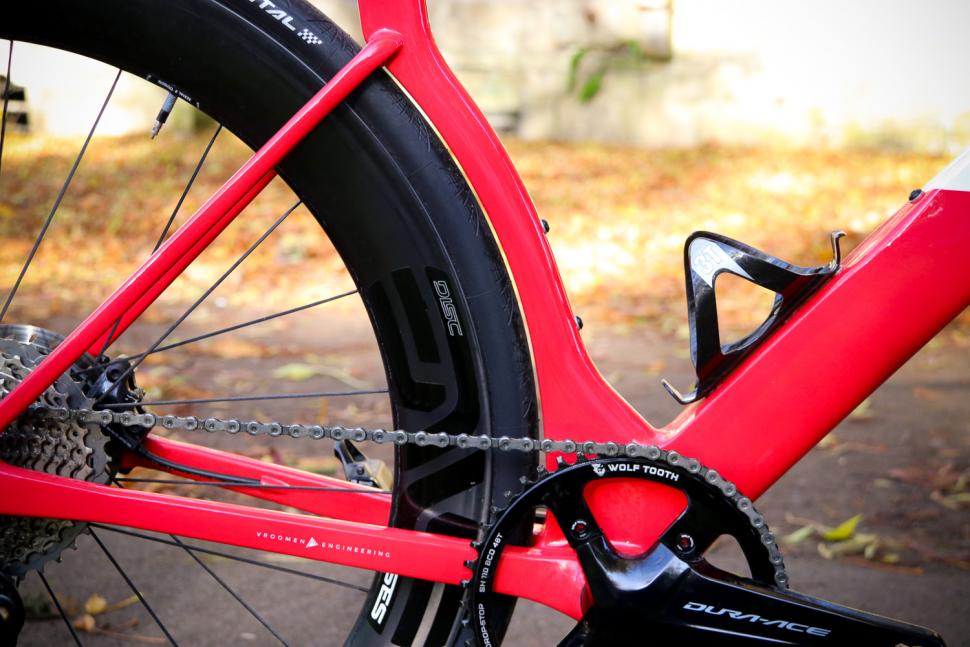
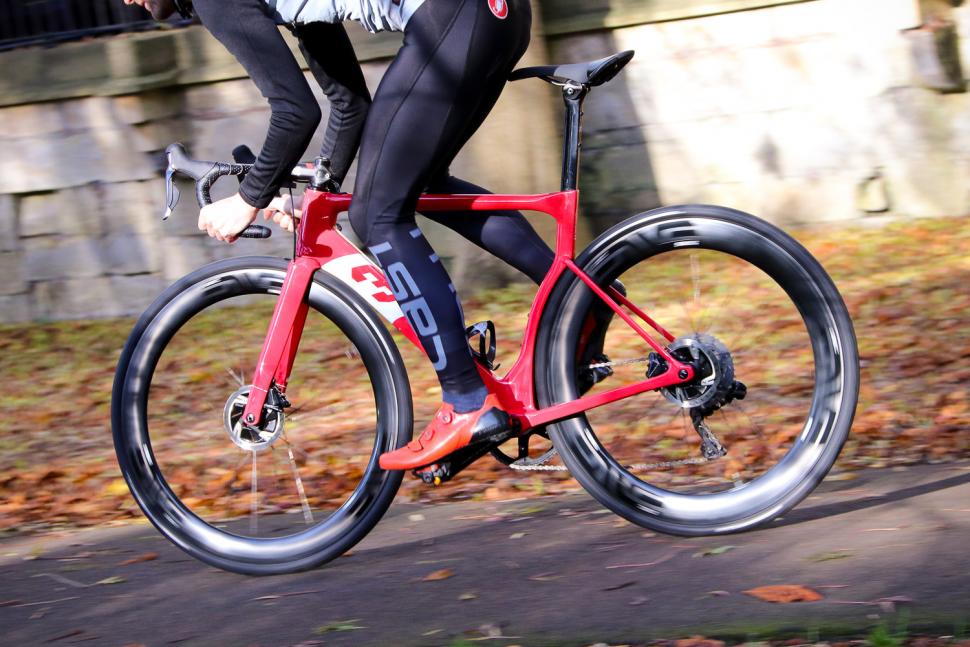



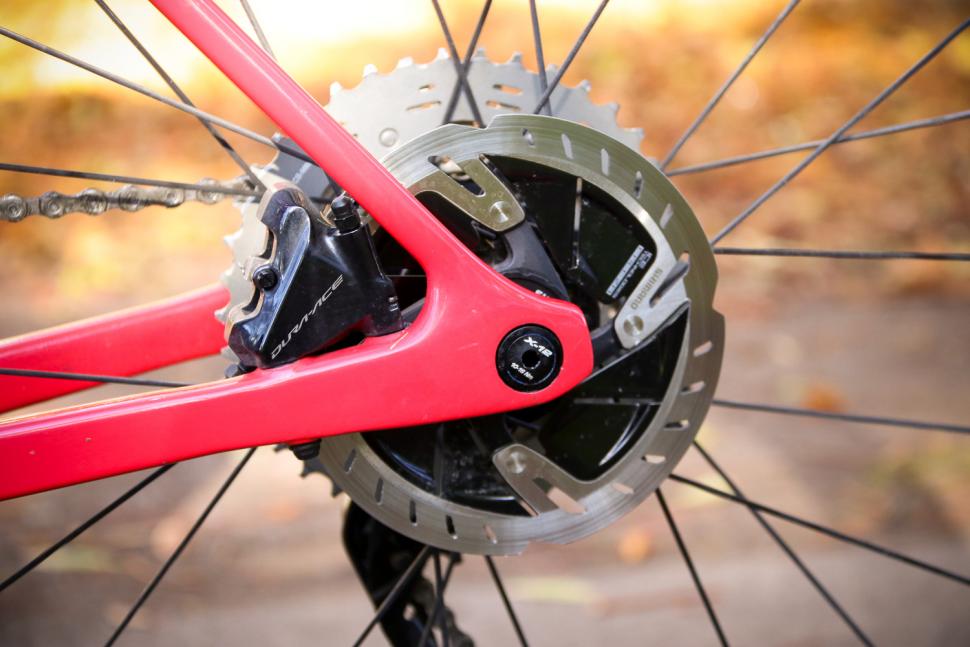

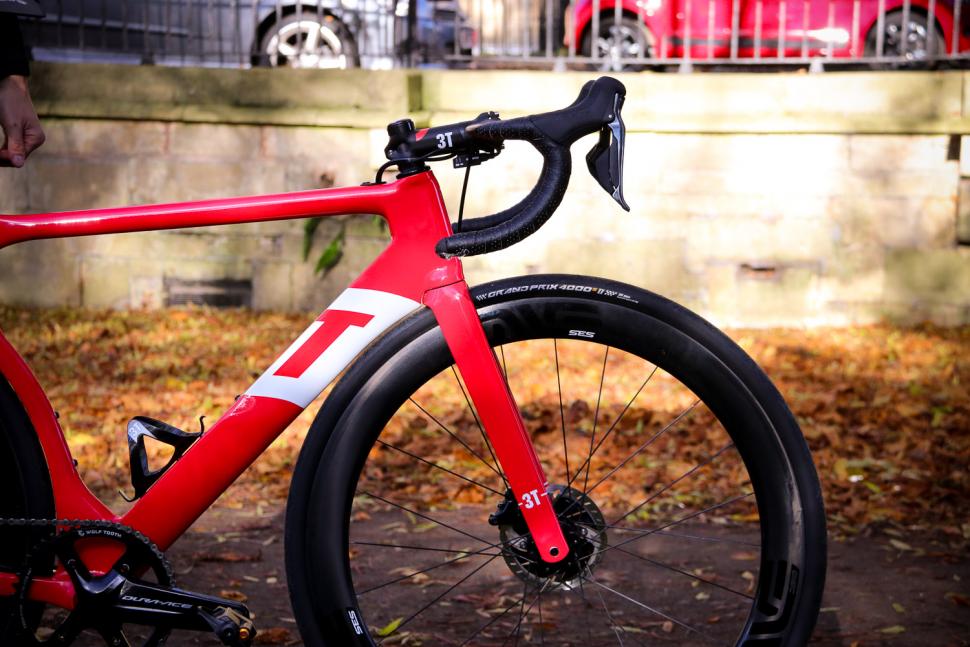
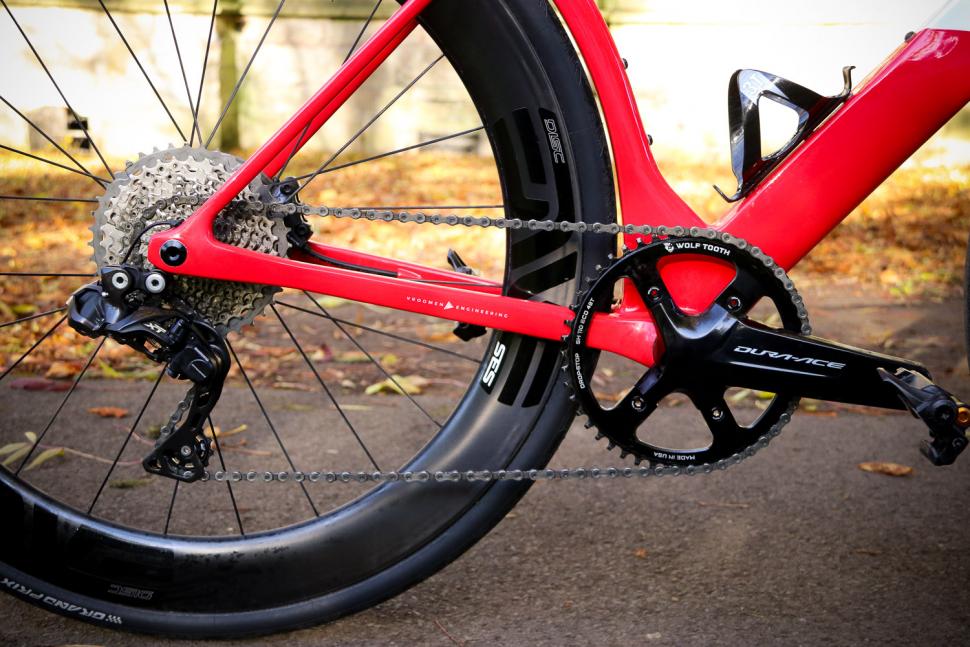


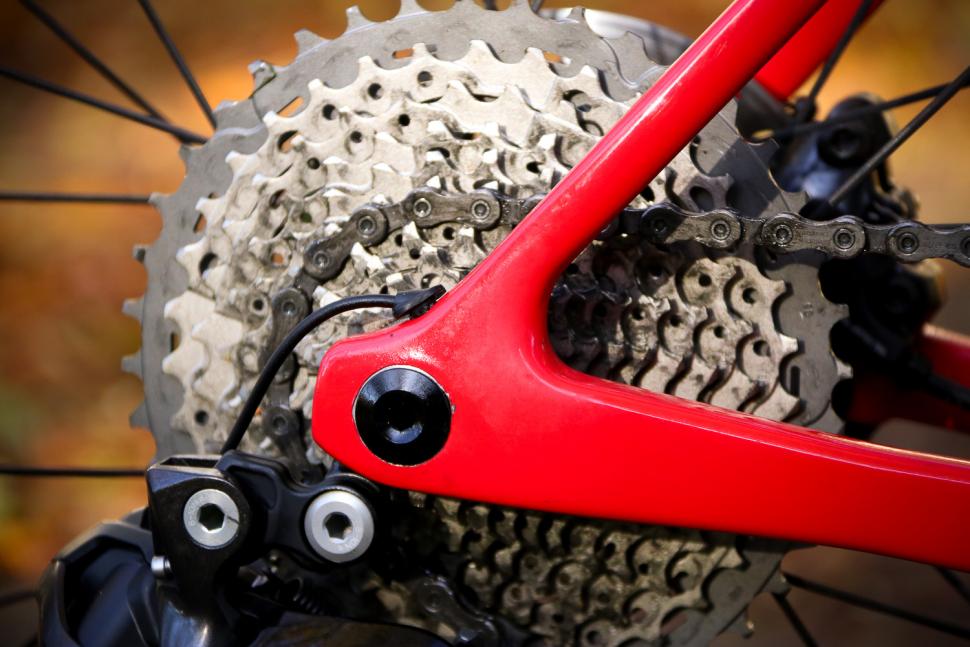

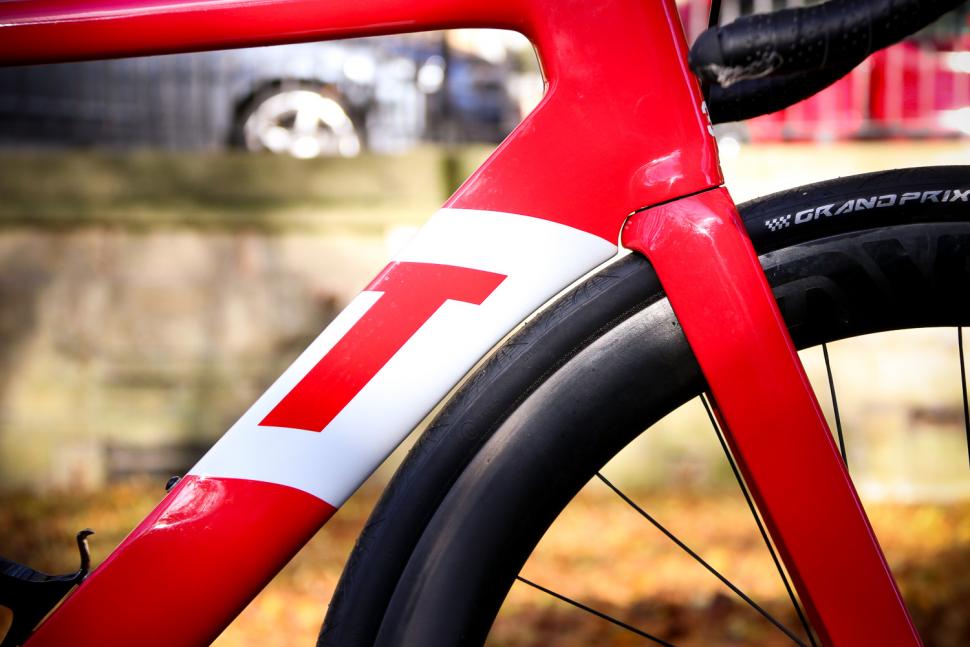
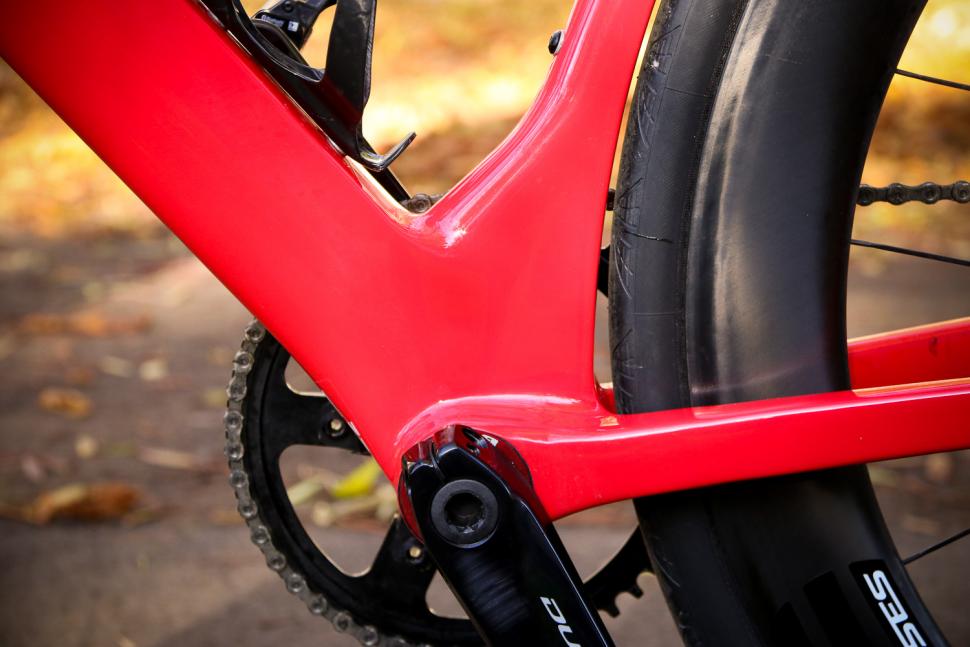
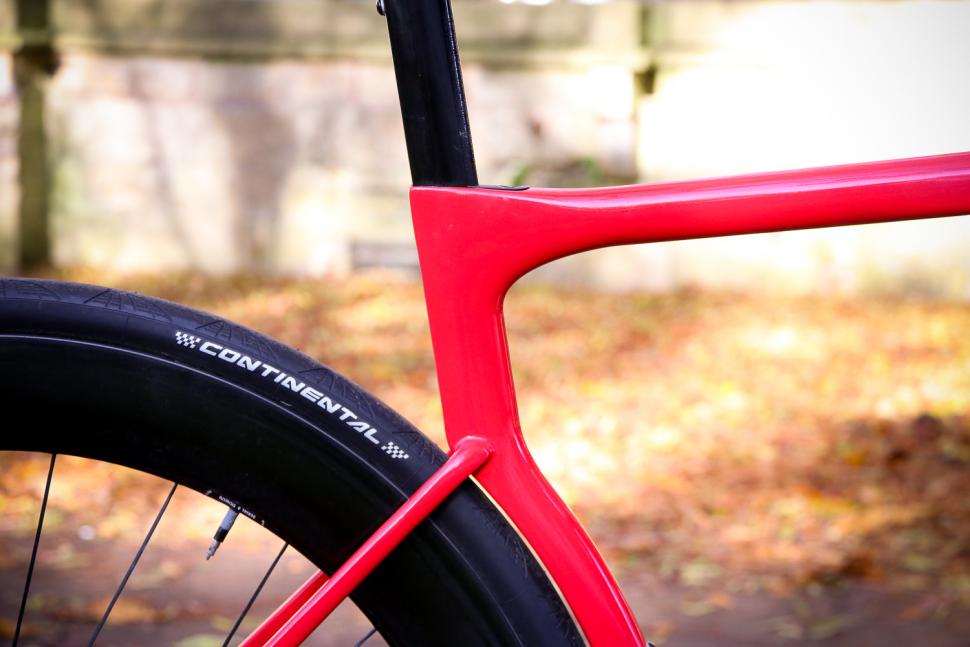
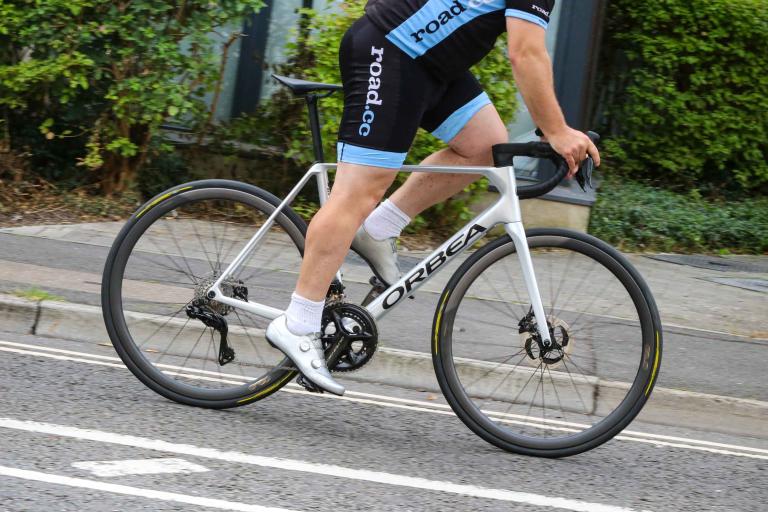
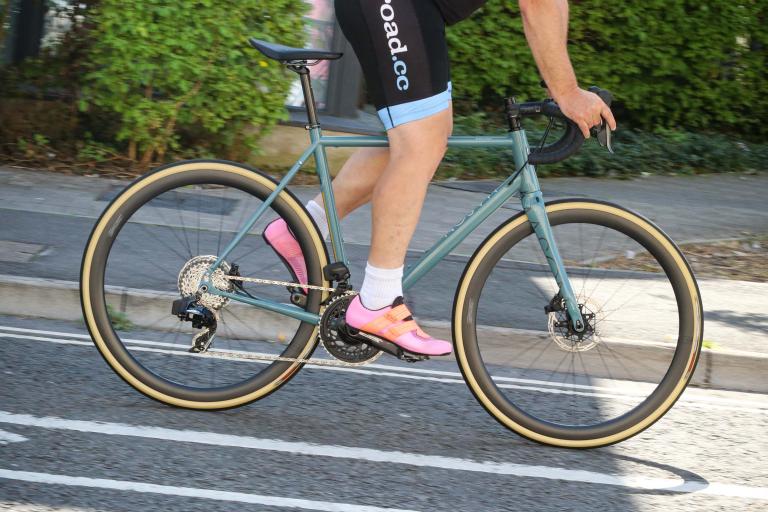
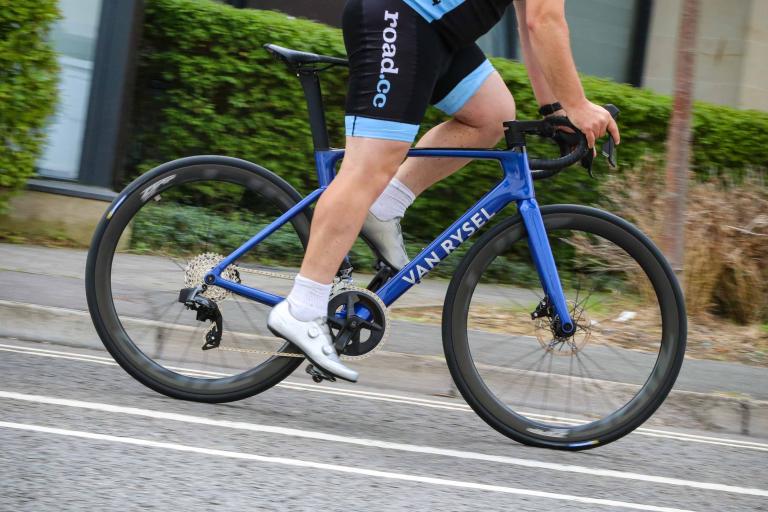
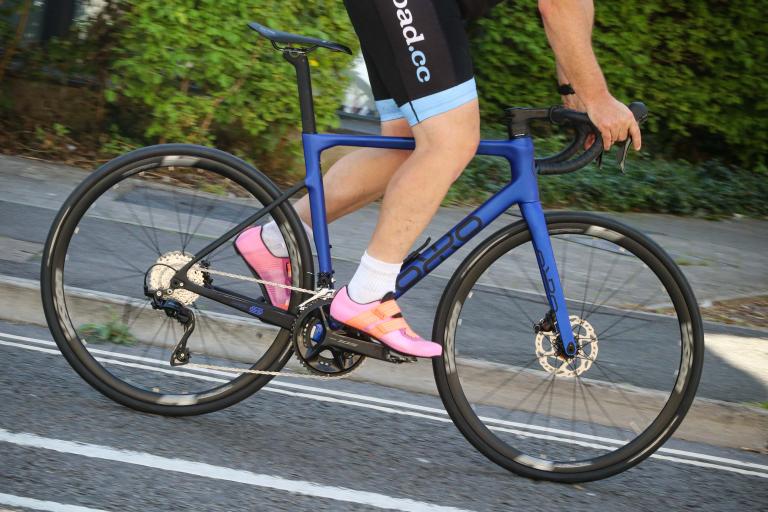
Add new comment
42 comments
I've had a Strada for 2 months and I agree with pretty much everything in this review.
I started off with wide tires, but they didn't fit my aero wheels, so I went down to 25mm tires which are flush with the rims. The comfort is still good, though there is now a gap between the rear tire and the frame.
The single front chainring isn't a problem, I regularly change the size depending on my ride, and the general feeling is that it reminds me of a track bike, not surprising since it looks almost exactly like a Cervelo track bike.
I think this bike also makes a good triathlon bike for hilly courses, or for someone who doesn't want to spend a fortune on a dedicated triathlon bike.
I should mention that I managed to get the total weight down to 7.1kg, with pedals and power meter (Favero Assioma) without too much problem, just an Extralite stem (87g), a KCNC 11-42 cassette (299g), and DT PRC 35mm wheels. This pretty much dispels the common notion that aero bikes are heavy.
There are quirks with the bike. First of all, since it's an aero bike it has a proprietary seatpost and 3T doesn't seem to sell spare seatposts. Compare this to Cervelo which has two types of seatposts for its aero bikes and sells them online.
For anyone thinking of buying an aero bike online, the curved seat tube and offset angled seatpost make it very hard to estimate saddle height measured on a normal road bike from the bottom bracket following the straight seat tube to the top of the saddle. Since I was ordering the frame, I took a screen capture of the frame on the 3T website and used screen coordinates to estimate the seatpost angle. I contacted 3T and they replied, confirming my computation. They also explained the range of the seat clamp, which is +/- 12.5mm. Correspondence with the 3T technical team was good, I would not have bought the frame otherwise. Thankfully, everything worked out and my saddle is right in the middle of the clamp adjustment range.
However, the bicycle is idiosyncratic, to say the least. The seatpost is proprietary The seatpost comes in one length and in my case it had to be cut in order to get my correct saddle height (700m for a size S). It has not slipped and works correctly at the recommended torque setting.
The seat clamp is not very good and caused a lot of problems. The basic problem is that it uses a "pinch" type system, in which the clamp squeezes against the rails. In pretty much every other clamp, there is a cradle, in which the seat is supported from below. This causes problems because it is much harder to hold something by pinching it then by holding it against the force acting on it, pinching works by increasing normal force (perpendicular force) to increase static friction. As an example, try to pick up a 20kg weight by pinching it, as opposed to picking it up from below.
Now, the advantage of a "pinch" system is that tightening is independent of position, so you can set the exact seat angle and then tighten. With a cradle, you change the seat angle when you tighten. In theory, the pinch system is better, but in practice not so much, because you can't make adjustments without the bike being on level ground and using a spirit level. With the standard method, you can make relative adjustements by untightening by a fixed number of turns, then adjusting by a fixed number of turns and retightening by the same amount, independent of bike position, in particular, during a ride. To summarize, pinch system clamps are not good and should be avoided.
It turns out that 3T has an instructional video on how to tighten the clamp, there is a pin that has to go through a hole, otherwise no amount of tightening will work, and then has to be tightened to 9Nm. However, the bolt uses Torx 27, which does not come with any torque wrench set anywhere, so I had to order the T27 bit just for this clamp, and it cost a fair bit of money.
The seatpost also has water bottle bosses, but it is impossible to fit a water bottle there. I bought a Wolftooth water bottle adapter, but that didn't work either. I can't understand why they put them there. In the end, I managed to fit a Topeak mini pump using their center bracket.
Now that everything is in order, I've been enjoying the bike a lot.
-ilan
StradaFinal20180714.JPG
Here is a review of a bike. Which most people would view as being not just the frame, but the whole package, because, how can you tell how much good is due to the frame, or the wheels, or the kit. But, I'm not going to tell you how much the bike costs, because I haven't even worked it out?
Really?? Puff piece or proper review of the frame?
If you are just reviewing the frame, and that is all you give a price for, what on earth is the point in telling us how good dura ace disc brakes are?? Irrelevant to the scope of this "frame" review.
*
1. Can you fit mudguards? (looks impossible)
2. If not, then it's for use in summer, right?
3. So why do you need disks?
You don't need discs. But they're better.
I have a gravel bike with hydraulic discs and a cervelo with Ultegra rim brakes. The rim brkes are really impressive, but the discs are just soooo much better. Even on sunny, dry roads.
I don't really get why you wouldn't have them unless it's a cost (obviously not the case with this bike) or weight. But even weight, you'd have to be building a hill climb bike or something for it to really make sense.
It'll be really interesting to see how Aqua Blue Sport get on with these next year.
I have my doubts about this set up but then I always have tended towards 'late adopter / laggard.'
I saw 3T Exploro frame up close last week and really liked it - it's something of a thug. However, I can't get over the massive sprockets; they just look all wrong on a road bike. My first race bike had a 13-18 6 speeed block (changed to a 15-20 for Junior racing) and I felt like a cheat when I moved from a 23 to a 25 a couple of years back.
Super bike review, the most interesting for ages! Good that you tackle the key misgiving, on clearances. And what an intelligent way to configure 1x with Shimano Di2! The very high build cost of this bike could be mitigated by substituting Ultegra 8000, an XT rear mech, and HUNT 30Carbon Aero Disc wheels. Even so, it's still the price many would consider a reasonable budget for a family car. Better start saving!
I've got a 2 year old Propel with clearances bigger than that; it's not great on rural roads at this time of year. That must be a nightmare!
And for me the gearing is comprised; 11 speed Ultegra is brilliant and with a 52-36 you have most eventualities covered without stupid gaps between each cog.
Did you read the review ? Quite a lot about how the clearance wasn't an issue through the test period, even on rural roads.
Vroomen’s design utilises a new and exclusive type of physics that Giant can’t access yet
Have you ridden a bike with small clearances on UK roads?! I think the tester may have got lucky with the conditions, because in my experience, current road conditions and small clearances just equals mess and stopping to clear cack, and then longer cleaning the bike afterwards.
It's possible I got lucky, but I don't think I did. I got this bike caked in mud, really tried my hardest to get the wheels jammed up with the frame. Funnily enough, I've been back on a regular race bike with rim brakes and twice had issues with clearance between the brake and tyre, the first time I had to stop to remove a twig. Go figure
Go figure indeed. Go figure why you're still ignoring the clear and obvious mistakes you've made in talking about the geometry of this bike.
Honestly I don't get it - this is your job. Why don't you want to learn something that would make you better at it?
Just buy a winter bike and shut up.
Comparing the geometry with my 'traditional' Enigma Esprit, very different bike apparently. For same 55cm top tube length (the measure I usually start with as a size requirement) the head tube on my Enigma is 135mm and 143mm on the Strada, but the stack is 550mm versus 535 on Strada, so the fork on the Strada must be quite a bit shorter to still end up 15mm lower than mine. Main advantage I would have thought is placing the wheel/tyre slightly closer to downtube. Overall though, despite the looks, the geometry doesn't seem radical at all.
Hi David; one thing that occurred to me with this when looking at the particular build you rode - did you never worry somewhat that you would be spinning out the 48T ring rather more than you might hope for? its quite a low gear, having 48x11 as your maximum. Just wondered - in most cases a stronger rider will overrun a compact, never mind a 48.
I hear your concern...Spinning out is never a worry for me! I could easily hit 55-60kph before spinning out, and that's plenty fast enough for normal real-world riding. At those sorts of speeds on the descents, there's more to be gained from getting aero
If it's too low you could put a 50t, or bigger chainring on it.
It's worth looking at the difference in gear inches. This 48x11 setup translates to 116.38in, a 50x11 (typical compact setup) provides a gearing of 121.45in. There's not much in it really.
Outside of racing, who is constantly riding in the 50x11 really?
The other part of this is that if you're spinning out at 60, it's probably because you're on your way to 80kph. So whether you spin out at 60 or at 65, it doesn't really matter, terminal velocity is the same, you may just get there two revolutions sooner.
What's the mudguard clearance & fitting like?
I take it it can take two water bottles ? As shown it doesnt look like it but I think theres another boss on the down tube to move the first cage up a bit ?
Yes there's space for two bottle cages, which I did try during testing - here's an Instagram video showing it with two cages www.instagram.com/p/BbZjVNBlrYn/ Probably not as aero as having the single cage lower down on the seat tube though, but necessary for longer rides
Fair play there. You have got the bike nice and muddy.
I wonder if with clearances that tight does the frame almost do the job of mudguards ?
❤️.
It is interesting that the focus on tightening up the gear ratio jumps is always on the small end of the cog (i.e. 10,11,12,13 teeth). I (and I suspect many others) don't spend much time down that end of the cog whether its a 1x or 2x system. Even long descending I tend to find myself quickly in the 13 and then jump to 11.
Hence for me a far better cassette that showed genuine sympathy for club/weekend riders would be something like this -
11-13-14-15-16-17-19-21-23-25-28
or for 1x roadsystems then this -
10-13-15-16-17-19-21-24-28-32-37 (I really, really would like someone to make this cassette!)
These ratios would give me the small adjustments in the critical mid area where my chain mainly is for club rides and still plenty of climbing/descending options
I thought the same about the gears. Most riders are only in the smallest two cogs going downhill anyway so I'd go something like 11-13-15-17-18-19-20-22-25-28-32, nice and tight in the middle but still with a big range.
To be fair to 3T, this is what they're partly trying to address with the Overdrive and Bailout. The Overdrive is swapping the initial 1T jumps for a slightly closer bunch in the upper half of the cassette (not the middle though) and the Bailout is trying to spread things more generally until the big jump to the eponymous bailout gear. Not ideal still but at least an indicator that people are thinking along similar lines to what you want.
Bit of a hotch potch build mixing road and mtb parts. Clearance isn’t an issue, if 28mm GP4000’s fit, more fast race tyres will also in 28mm. I’ve said from the beginning this frame is too far ahead of its time and will only attract a small niche of buyers. The current group set options are severely limited. I cannot see Campagnolo ever developing a 1x groupset. Shimano seem hesitant. As good as it may be, I’m not excited. Front derailleurs for the win....
"Bit of a hotchpotch build mixing road and mtb parts"
It might be a hotchpotch but it works. A SRAM Force groupset is the other alternative of course. I'm sure there'll be other options along in 2018...
"I’ve said from the beginning this frame is too far ahead of its time and will only attract a small niche of buyers."
Is that a bad thing?
People thought that about Campag discs yet there they are. Campag are aware of trends and the need to compete. I'm sure they're looking at 1x and will bring out an offering if 1x gains traction on road bikes.
Do you expect Shimano to sing the praises of 1x when their competitor is the only one who sells it? I can guarantee you there are some Japanese engineers working overtime and when they're ready, the hesitation will be gone.
Pages